Attached files
| file | filename |
|---|---|
| 8-K - KAMAN CORPORATION FORM 8-K DATED JANUARY 15, 2013 - KAMAN Corp | form8-k.htm |

1
CJS Securities, Inc.
13th Annual “New Ideas for the New Year” Conference
January 16, 2013

2
Forward Looking Statement
This presentation contains "forward-looking statements" within the meaning of the safe harbor provisions of the U.S. Private Securities Litigation Reform Act of 1995.
Forward-looking statements also may be included in other publicly available documents from time to time issued by the Company and in oral statements from time to
time made by our officers and representatives. These forward-looking statements are intended to provide management's current expectations or plans for the
Company's future operating and financial performance, based on assumptions currently believed to be valid. They can be identified by the use of words such as
"anticipate," "intend," "plan," "goal," "seek," "believe," "project," "estimate," "expect," "strategy," "future," "likely," "may," "should," "will" and other words of similar meaning
in connection with a discussion of future operating or financial performance. Examples of forward looking statements include, among others, statements relating to
future sales, earnings, cash flows, results of operations, uses of cash and other measures of financial performance.
Forward-looking statements also may be included in other publicly available documents from time to time issued by the Company and in oral statements from time to
time made by our officers and representatives. These forward-looking statements are intended to provide management's current expectations or plans for the
Company's future operating and financial performance, based on assumptions currently believed to be valid. They can be identified by the use of words such as
"anticipate," "intend," "plan," "goal," "seek," "believe," "project," "estimate," "expect," "strategy," "future," "likely," "may," "should," "will" and other words of similar meaning
in connection with a discussion of future operating or financial performance. Examples of forward looking statements include, among others, statements relating to
future sales, earnings, cash flows, results of operations, uses of cash and other measures of financial performance.
Because forward-looking statements relate to the future, they are subject to inherent risks, uncertainties and other factors that may cause the Company's actual results
and financial condition to differ materially from those expressed or implied in the forward-looking statements. Such risks, uncertainties and other factors include, among
others: (i) changes in domestic and foreign economic and competitive conditions in markets served by the Company, particularly the defense, commercial aviation and
industrial production markets; (ii) changes in government and customer priorities and requirements (including cost-cutting initiatives, the potential deferral of awards,
terminations or reductions of expenditures to respond to the priorities of Congress and the Administration, or budgetary cuts resulting from Congressional actions or
automatic sequestration under the Budget Control Act of 2011); (iii) changes in geopolitical conditions in countries where the Company does or intends to do business;
(iv) the successful conclusion of competitions for government programs and thereafter contract negotiations with government authorities, both foreign and domestic; (v)
the existence of standard government contract provisions permitting renegotiation of terms and termination for the convenience of the government; (vi) the satisfactory
conclusion to government inquiries or investigations regarding government programs, including the satisfactory resolution of the Wichita subpoena matter; (vii) risks and
uncertainties associated with the successful implementation and ramp up of significant new programs; (viii) potential difficulties associated with variable acceptance test
results, given sensitive production materials and extreme test parameters; (ix) the successful resale of the SH-2G(I) aircraft, equipment and spare parts; (x) the receipt
and successful execution of production orders for the JPF U.S. government contract, including the exercise of all contract options and receipt of orders from allied
militaries, as all have been assumed in connection with goodwill impairment evaluations; (xi) the continued support of the existing K-MAX® helicopter fleet, including sale
of existing K-MAX® spare parts inventory; (xii) the accuracy of current cost estimates associated with environmental remediation activities at the Bloomfield, Moosup and
New Hartford, CT facilities and our U.K. facilities; (xiii) the profitable integration of acquired businesses into the Company's operations; (xiv) changes in supplier sales or
vendor incentive policies; (xv) the effects of price increases or decreases; (xvi) the effects of pension regulations, pension plan assumptions, pension plan asset
performance and future contributions; (xvii) future levels of indebtedness and capital expenditures; (xviii) the future availability of credit and the Company's ability to
maintain its current credit rating; (xix) the continued availability of raw materials and other commodities in adequate supplies and the effect of increased costs for such
items; (xx) the effects of currency exchange rates and foreign competition on future operations; (xxi) changes in laws and regulations, taxes, interest rates, inflation rates
and general business conditions; (xxii) future repurchases and/or issuances of common stock; and (xxiii) such other risks and uncertainties as are discussed in Part II,
Item 1A. "Risk Factors" of our Quarterly Reports on Form 10-Q for the quarters ended June 29 and September 28, 2012 and in Part I, Item 1A. “Risk Factors” of our
Annual Report on Form 10-K for the year ended December 31, 2011.
and financial condition to differ materially from those expressed or implied in the forward-looking statements. Such risks, uncertainties and other factors include, among
others: (i) changes in domestic and foreign economic and competitive conditions in markets served by the Company, particularly the defense, commercial aviation and
industrial production markets; (ii) changes in government and customer priorities and requirements (including cost-cutting initiatives, the potential deferral of awards,
terminations or reductions of expenditures to respond to the priorities of Congress and the Administration, or budgetary cuts resulting from Congressional actions or
automatic sequestration under the Budget Control Act of 2011); (iii) changes in geopolitical conditions in countries where the Company does or intends to do business;
(iv) the successful conclusion of competitions for government programs and thereafter contract negotiations with government authorities, both foreign and domestic; (v)
the existence of standard government contract provisions permitting renegotiation of terms and termination for the convenience of the government; (vi) the satisfactory
conclusion to government inquiries or investigations regarding government programs, including the satisfactory resolution of the Wichita subpoena matter; (vii) risks and
uncertainties associated with the successful implementation and ramp up of significant new programs; (viii) potential difficulties associated with variable acceptance test
results, given sensitive production materials and extreme test parameters; (ix) the successful resale of the SH-2G(I) aircraft, equipment and spare parts; (x) the receipt
and successful execution of production orders for the JPF U.S. government contract, including the exercise of all contract options and receipt of orders from allied
militaries, as all have been assumed in connection with goodwill impairment evaluations; (xi) the continued support of the existing K-MAX® helicopter fleet, including sale
of existing K-MAX® spare parts inventory; (xii) the accuracy of current cost estimates associated with environmental remediation activities at the Bloomfield, Moosup and
New Hartford, CT facilities and our U.K. facilities; (xiii) the profitable integration of acquired businesses into the Company's operations; (xiv) changes in supplier sales or
vendor incentive policies; (xv) the effects of price increases or decreases; (xvi) the effects of pension regulations, pension plan assumptions, pension plan asset
performance and future contributions; (xvii) future levels of indebtedness and capital expenditures; (xviii) the future availability of credit and the Company's ability to
maintain its current credit rating; (xix) the continued availability of raw materials and other commodities in adequate supplies and the effect of increased costs for such
items; (xx) the effects of currency exchange rates and foreign competition on future operations; (xxi) changes in laws and regulations, taxes, interest rates, inflation rates
and general business conditions; (xxii) future repurchases and/or issuances of common stock; and (xxiii) such other risks and uncertainties as are discussed in Part II,
Item 1A. "Risk Factors" of our Quarterly Reports on Form 10-Q for the quarters ended June 29 and September 28, 2012 and in Part I, Item 1A. “Risk Factors” of our
Annual Report on Form 10-K for the year ended December 31, 2011.
All forward-looking statements made in this presentation are based solely on information that is currently available as of the date of this presentation, and the Company
undertakes no obligation to update any such forward-looking statement, whether as a result of new information, future developments or otherwise.
undertakes no obligation to update any such forward-looking statement, whether as a result of new information, future developments or otherwise.
Contact: Eric Remington
V.P., Investor Relations
(860) 243-6334
Eric.Remington@kaman.com

3
Kaman Corporation Overview
• Two businesses
– Aerospace
• Manufacturer and subcontractor in the global commercial aerospace
and defense market - extremely broad range of capabilities - proven
performance
and defense market - extremely broad range of capabilities - proven
performance
• Diverse and growing customer base of blue chip customers and
government divisions
government divisions
– Distribution
• Third largest distributor in the power transmission/motion
control/fluid power market
control/fluid power market
• Focused on technical differentiation and expansion into higher
margin products
margin products
• Publicly listed on the NYSE with a market capitalization of
approximately $1 billion
approximately $1 billion
• 2011 sales $1.5 billion; 5,000 employees
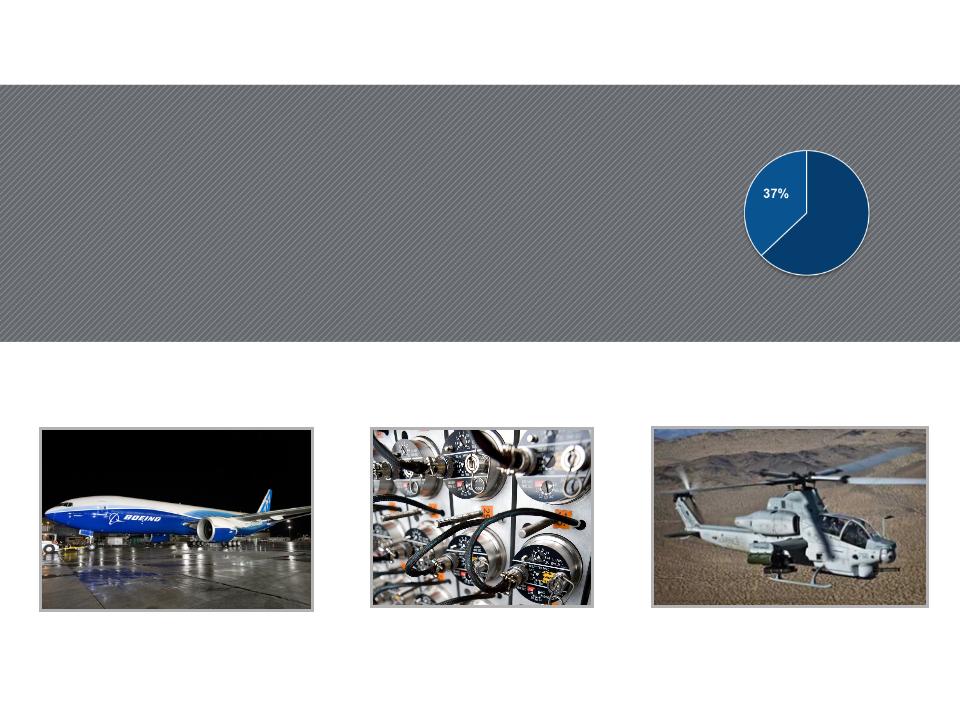
4
2011 Sales: $547 million
Aerospace

5
36%
19%
12%
45%
Aerospace - 2011 Sales Overview
63%
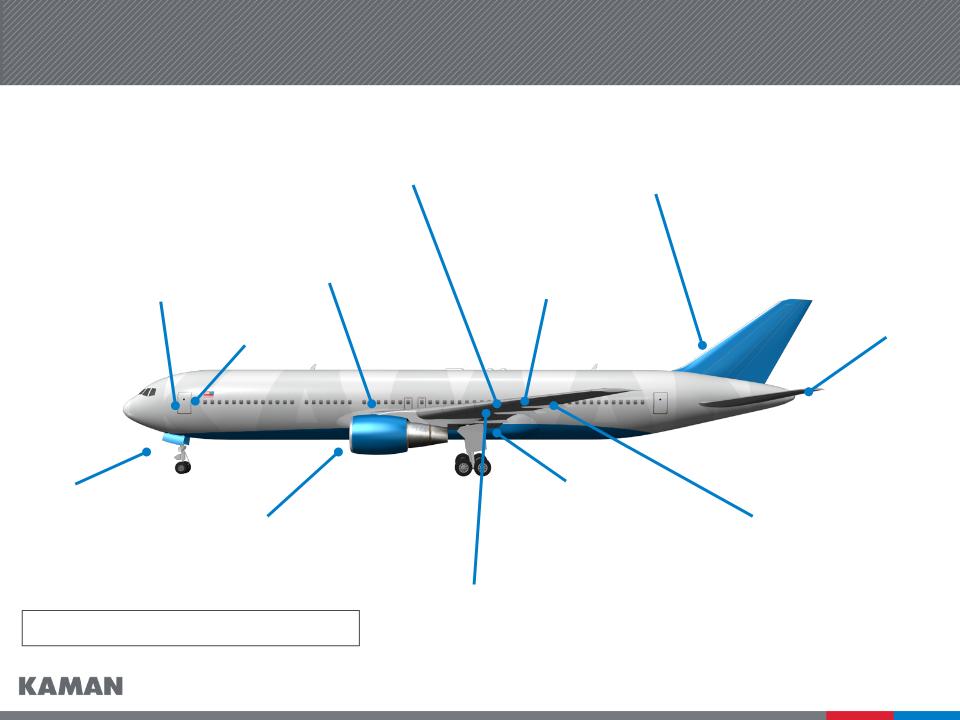
6
Fixed trailing edge
Fuel tank access doors
Top covers
Red denotes bearing products
Nose landing gear
Horizontal
stabilizer
stabilizer
Main landing gear
Flaps
Rudder
Door assemblies
Engine/thrust reverser
Aircraft Programs/Capabilities
Flight controls
Doors

7
Manufacture of cockpit
Blade erosion coating
Manufacture and assembly
of tail rotor pylon
of tail rotor pylon
Manufacture,
subassembly and
joining of fuselage
subassembly and
joining of fuselage
Blade manufacture,
repair and overhaul
repair and overhaul
Driveline couplings
Bushings
Flight control bearings
Aircraft Programs/Capabilities
Red denotes bearing products

8
Market leading self lube airframe bearing product lines
• Content on virtually every aircraft manufactured today with a
growing installed base
growing installed base
• Approximately 75% of sales are for commercial applications
• Proprietary technology:
– KAron® bearing liner system
– KAflex® and Tufflex® flexible couplings
• 95% of sales are for custom engineered applications
• Operational excellence through lean manufacturing
• World class application engineers and material scientists
developing new applications
developing new applications

9
• USAF bomb fuze of choice
• USAF inventory levels are less than
half desired quantity
half desired quantity
• USAF reprogramming $20 million to
JPF procurement
JPF procurement
• $92 million backlog (as of 9/28/2012) for
delivery through 2013
delivery through 2013
• Kaman is sole source, negotiating
four year follow-on contact
four year follow-on contact
• 23 foreign customers
Bomb Compatibility
- JDAM
- Paveway II and III
- GBU-10, 12, 16, 24, 27, 28, 31,
32, 38, 54
32, 38, 54
- BLU-109, 110, 111, 113, 117,
121, 122, 126
121, 122, 126
- MK82/BSU-49, MK83/BSU-85,
MK84/BSU-50
MK84/BSU-50
JPF Program

10
Aerospace Issues for 2013
• Manage continued growth of bearing product lines driven by
commercial build rates
commercial build rates
• Continue reinvestment in specialty bearing product lines
– Business development
– Facility expansion in Europe
• Continue to pursue strategic acquisitions that enhance shareholder
value
value
• Focus on cash flow generation
– Successful program ramp ups (e.g. AH-1Z)
– Sound program management
– Continue to work toward the sale of SH-2G(I) aircraft
• Manage strategic transition

11
Aerosystems
• Combines our diverse offerings
– Design
– Tooling
– Manufacturing
– Machining
– Assembly
– MRO and support
• Will maximize efficiencies across businesses
• Allows Kaman to go to market in a cohesive integrated manner

12
Aerospace - Budget Impact on Defense Programs
• Key defense programs less impacted by proposed budget cuts
– Joint Programmable Fuze - backlog into 2013, foreign demand,
continued sole source
continued sole source
– F-35 (Joint Strike Fighter) - incremental business at any
production level
production level
– A-10 re-wing program for Boeing - reset, new business
– AH-1Z integrated fuselage for Bell/USMC - new business
• Broadly diverse revenue base mitigates risk from large program
cancellations
cancellations
• Anticipated risk to revenue from sequestration is $20 million to $25
million in 2013, less than 2% of expected consolidated revenue
million in 2013, less than 2% of expected consolidated revenue
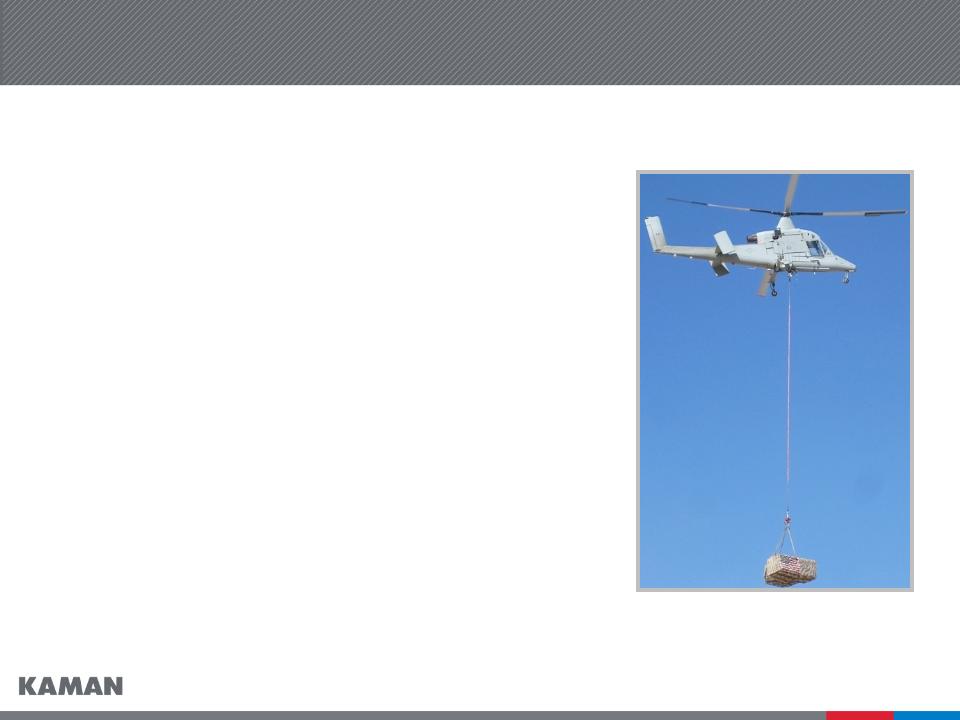
13
Unmanned K-MAX®
• Kaman/Lockheed have developed an unmanned
military version of the K-MAX helicopter
military version of the K-MAX helicopter
• Two K-MAXs have been performing unmanned
cargo resupply missions for the USMC in
Afghanistan since December 2011
cargo resupply missions for the USMC in
Afghanistan since December 2011
• Lockheed Martin awarded Army and Navy
unmanned K-MAX development contracts to
expand mission capability
unmanned K-MAX development contracts to
expand mission capability
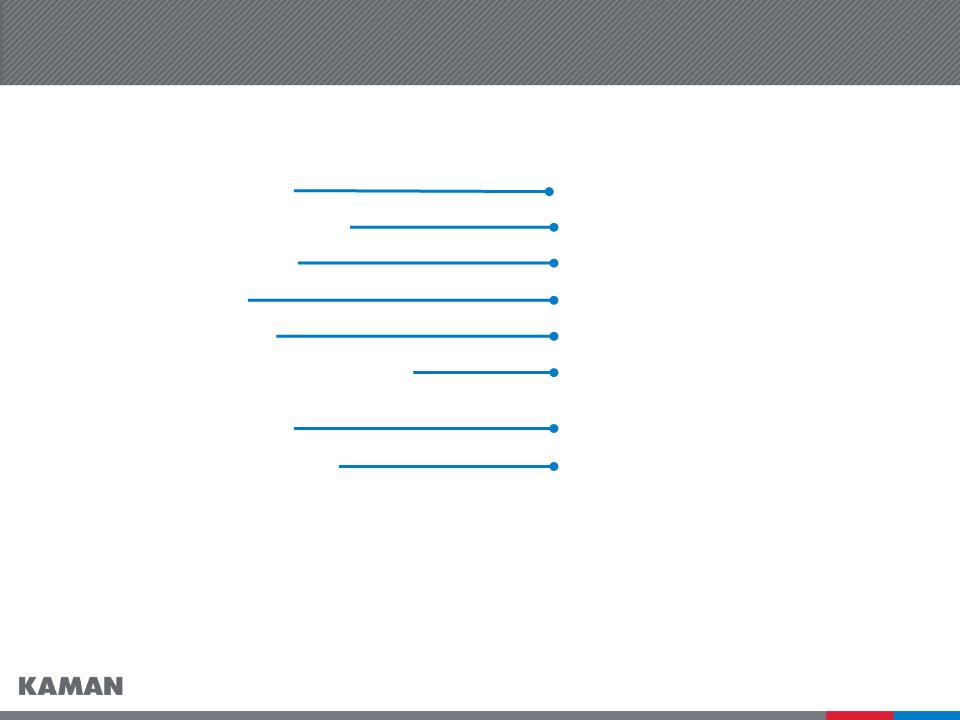
14
Aerospace Strategic Transition
$1 Billion sales
“High Teens” operating margin
50% Design-and-build
50% Defense/50% Commercial
Super Tier II
Integrated, coordinated, synergistic
business
business
Multi-national
Competing on design-and-build
manufacturing capability, and
Intellectual Property
manufacturing capability, and
Intellectual Property
NOW
FUTURE/VISION
$547 Million sales
15.8% Operating margin
70% Build-to-print
65% Defense
Tier II/III Supplier
Small, independent businesses
Primarily domestic
Competing on cost and
manufacturing capability
manufacturing capability
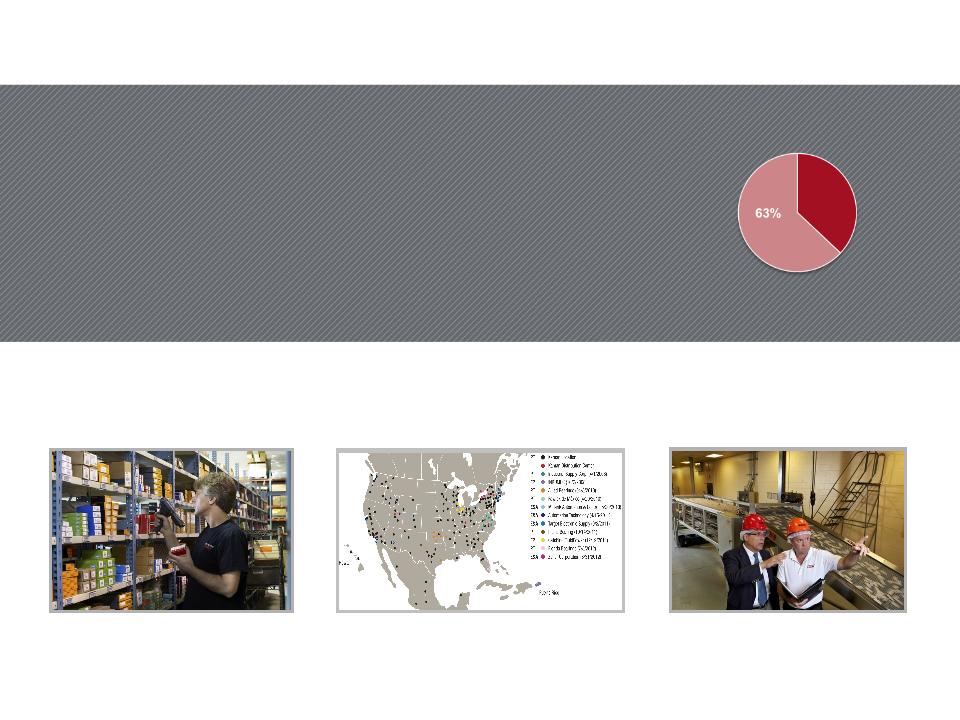
15
Distribution
2011 Sales: $951 Million

16
Distribution Overview
• Industrial distribution firm with a $35 billion served market via three platforms
– Bearings and mechanical power transmission
– Fluid power
– Electrical automation and control
• Major product categories
– Bearings
– Mechanical and electrical power transmission
– Fluid Power
– Motion control
– Automation
– Material handling
– Electrical control and power distribution
• 234 locations and 5 distribution centers
• Executing growth strategy to achieve long-term sales and profit objectives

17
Distribution - Major Product Platforms
|
Product Platform
|
Bearings & Mechanical Power
Transmission (BPT)
|
Fluid Power
|
Electrical Automation
& Control |
|
% of 2011 Sales
(approximate)
|
72%
|
12%
|
16%
|
|
Market Size
|
$12.5 Billion
|
$7.2 Billion
|
$15.0 Billion
|
|
Acquisitions
since 2008 |
•Industrial Supply Corp.
•Allied Bearings Supply
•Plains Bearing
•Fawick de Mexico
•Florida Bearings
|
•Catching Fluidpower
•INRUMEC
|
•Zeller
•Minarik
•Automation Technology
•Target Electronic
Supply |
|
Major Suppliers
|
|
|
|
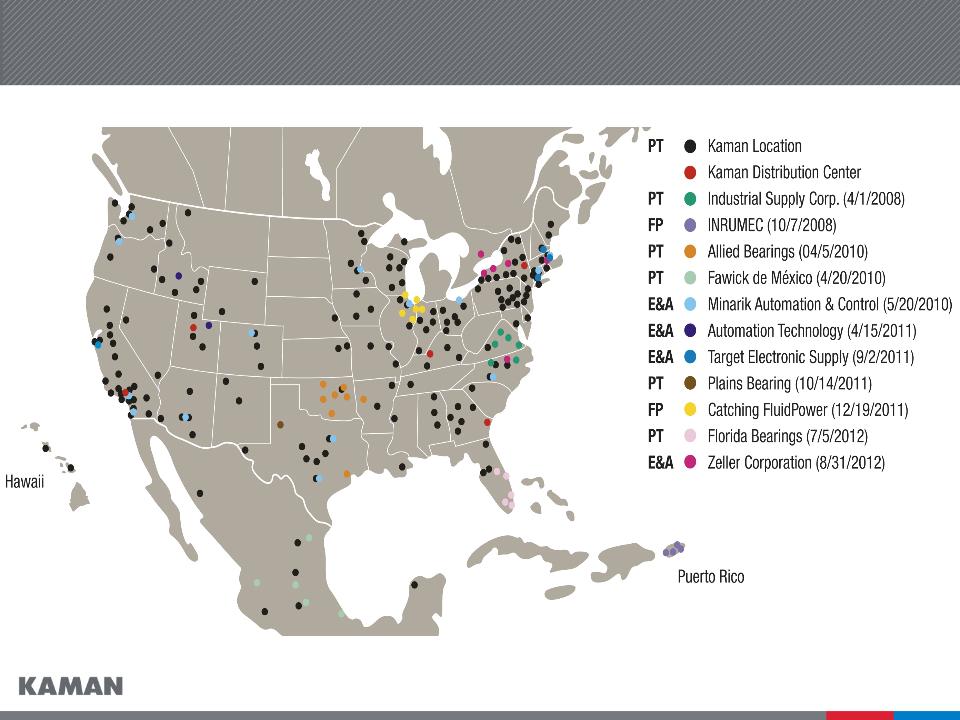
18
Executing Strategy and Building Network
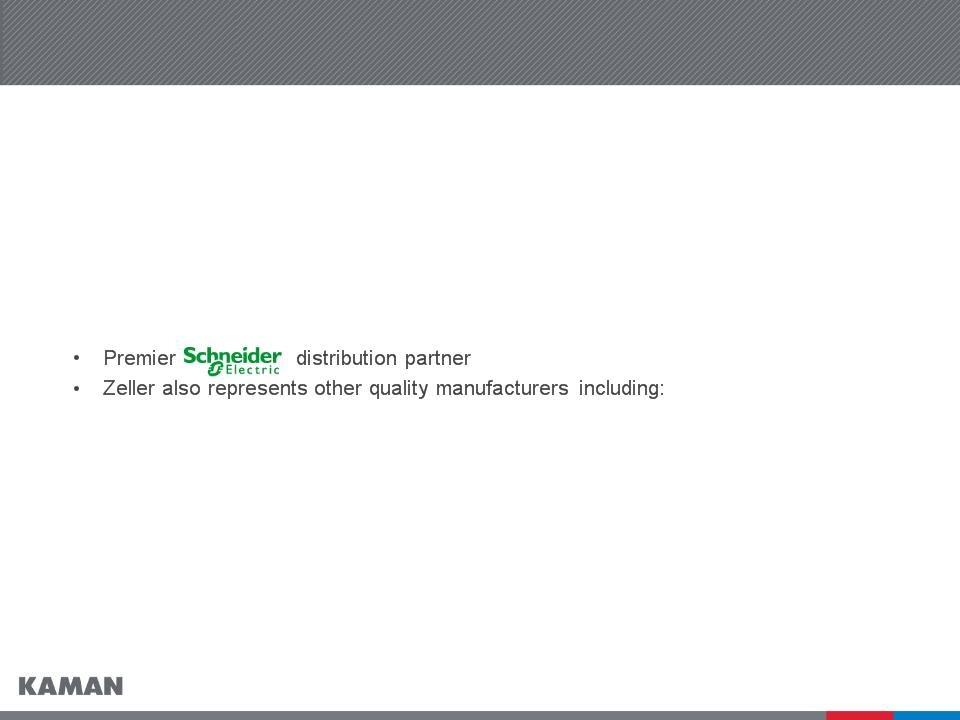
19
Acquisition of Zeller Corporation - Overview
• Acquired certain assets of Zeller Corporation on August 13, 2012
• Zeller is a value added distributor of electrical and automation components and
engineered systems provider, encompassing the following technologies:
engineered systems provider, encompassing the following technologies:
– Motion control
– PLC based automation
– Machine vision
– Electrical controls
– Power distribution products
– Kollmorgen
– Phoenix Contact
– Rittal
– Sick
– Zeller’s full year sales for 2012 are expected to be approximately $80 million with
an operating profit margin higher than that of Kaman’s Industrial Distribution
segment
an operating profit margin higher than that of Kaman’s Industrial Distribution
segment

20
Zeller - Summary of Merits
• Builds scale in Kaman’s automation and control (A&C) market
segment
segment
• Expands Kaman’s A&C served market to $15 billion by adding
electric control capabilities
electric control capabilities
• Adds Schneider as key vendor
• Establishes scale in value-added solutions
• Establishes Kaman as a provider of electrical controls products
• Expected to yield sales synergy opportunities from Kaman’s
national sales force
national sales force

21
Distribution Issues for 2013
• Monitor and react to organic sales growth rate
• Continue acquisition program
• Effectively integrate recent acquisitions and optimize cross-selling
opportunities
opportunities
• Continue disciplined implementation of the new ERP system
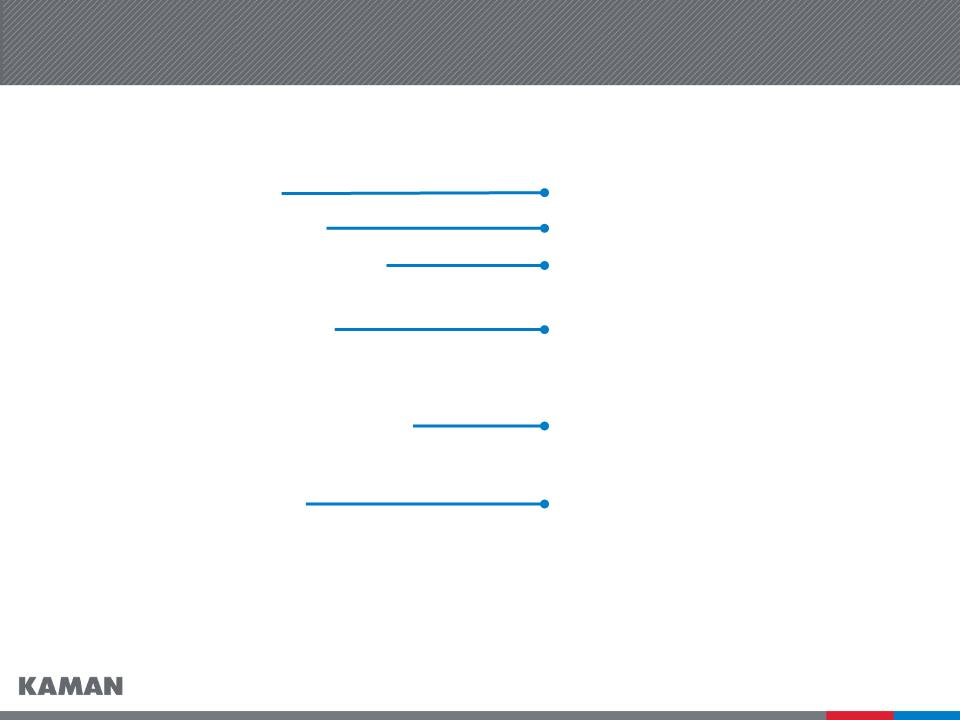
22
Distribution Strategic Transition
$951 Million Sales
5.1% operating margin
Presence in 72 of the top 100
industrial markets
industrial markets
Three product platforms
Narrow fluid power offering from
numerous single-technology
suppliers
numerous single-technology
suppliers
Eight ERP systems
NOW
FUTURE/VISION
$1.5 Billion sales
7.0% operating margin
Presence in ≈ 90 of the top 100 U.S.
industrial markets
industrial markets
Three major product platforms with
increased market share in
motion/automation and fluid power
increased market share in
motion/automation and fluid power
Broad fluid power offering from multi
-technology supplier
State of the art enterprise wide
business system
-technology supplier
State of the art enterprise wide
business system

23
Kaman Investment Merits
• A Leading Market Position in Both Business Segments
• Continued Focus on Profit Optimization, Increasing Cash Flows and
Strengthening Competitive Position
Strengthening Competitive Position
• Strong Liquidity and Conservative Financial Profile
• Disciplined and Focused Acquisition Strategy
• Experienced Management Team

24
Executive Compensation Aligned with Shareholder
Interests
Interests
• Alignment with the market allows Company to attract and retain key
talent
talent
• Company and individual performance drive base salary, annual
cash incentives and long-term incentives (75% of CEO’s
compensation in 2011 was performance related)
cash incentives and long-term incentives (75% of CEO’s
compensation in 2011 was performance related)
• Total compensation only reaches the median of market when
Company financial performance also is at the median of similar
sized industrial companies as measured by the Russell 2000
Company financial performance also is at the median of similar
sized industrial companies as measured by the Russell 2000
• The direct linkage to company financial performance serves
shareholder interests
shareholder interests
• SERP and Pensions benefit accruals ended in 2010
• Perquisites have essentially been curtailed for executive officers
(MERP, financial counseling, tax planning)
(MERP, financial counseling, tax planning)

25
Performance-Driven Annual Cash Incentive
• Annual cash incentive driven by financial performance
– Corporate - compared against the 5-year average of Russell
2000:
2000:
• Return on Investment
• EPS growth
• EPS performance against plan
• Individual Performance
– Business Units - compared against the 3-year moving average of
past performance
past performance
• Return on Investment
• Growth in operating income
• Additional annual objectives determined by business
priorities
priorities
• Reviewed and approved by the Personnel and Compensation
Committee of the Board of Directors
Committee of the Board of Directors

Q&A
